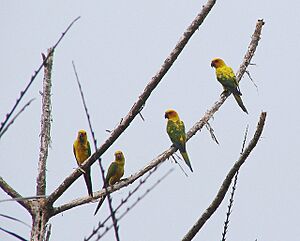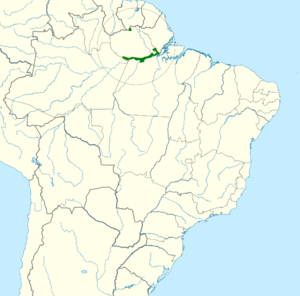Sulphur-breasted parakeet facts for kids
Quick facts for kids Sulphur-breasted parakeet |
|
|---|---|
 |
|
| Conservation status | |
| Scientific classification | |
| Genus: |
Aratinga
|
| Species: |
maculata
|
 |
|
| Synonyms | |
|
Aratinga pintoi Silveira, de Lima & Höfling, 2005 |
|
The sulphur-breasted parakeet (Aratinga maculata) is a colorful bird. It is also known as the sulphur-breasted conure. This parakeet is a type of parrot found in Brazil and Suriname. It looks a lot like its close relative, the sun parakeet.
Contents
About the Sulphur-breasted Parakeet
How Scientists Identified It
For a long time, scientists thought the sulphur-breasted parakeet was just a young sun parakeet. Some even thought it might be a mix of two different birds. But in 2009, after more study, experts agreed it was its own unique species. This bird was first described way back in 1776!
What It Looks Like
The sulphur-breasted parakeet is about 30 centimeters (12 inches) long. It weighs around 110 grams (3.9 ounces). Both male and female birds look the same.
Its head and back are a pale greenish-yellow. Its wings have colors from yellow to green and even deep blue. The tail is mostly green, but the tips of the feathers are blue.
Below its head and on its belly, the bird is mostly yellow. It has some orange around its eyes and on parts of its tummy. Its eyes are dark gray with bluish-gray skin around them. The beak is black, and its legs and feet are dark brownish.
Young parakeets have green heads, backs, and wing feathers. This bird is very similar to the sun parakeet. However, the sulphur-breasted parakeet has less orange and more green colors.
Where It Lives and Its Home
Its Home Range
The sulphur-breasted parakeet lives in two separate areas. One area is in Brazil, north of the Amazon River. The other is in Suriname, in a place called the Sipaliwini Savanna. It might also live in another part of Brazil called Amapá, but this has not been fully confirmed.
What Kind of Habitat It Likes
This parakeet prefers open or partly open areas. It often lives in places with sandy soil and scattered trees and bushes. You can also find it in forests along rivers. Sometimes, it visits fruit orchards. It can live in places as high as 1,400 meters (4,600 feet) above sea level.
How It Behaves
Daily Movements
The sulphur-breasted parakeet usually stays in the same area all year. However, it might move short distances locally to find food or a better place to live.
What It Eats
These parakeets look for food alone or in small groups. A group can have up to about 10 birds. They enjoy eating different kinds of fruit, seeds, and flowers.
Reproduction and Life Cycle
Sulphur-breasted parakeets make their nests inside holes in trees. Scientists have found active nests in April and September. Both nests were in dead Hymenaea trees. One nest had a single egg. Not much else is known about how these birds raise their young.
Its Calls
The sulphur-breasted parakeet makes a high-pitched, loud sound. People describe its call as a "screech" with 2 or 3 notes, like "screek screek screek." It can also sound like a sharp, very high shriek, like "eeuwt-uht-uht."
Its Conservation Status
The IUCN (International Union for Conservation of Nature) has listed the sulphur-breasted parakeet as a species of "Least Concern." This means it is not currently considered endangered.
Even though it lives in a somewhat small area and we don't know its exact population size, the number of these birds seems to be growing. Cutting down trees (deforestation) could be a problem. However, if it's not too much or too fast, it might actually help the birds. This is because it could create more open areas for them to live in. People catching them for pets doesn't seem to affect their numbers much either. It is thought to be quite common in both areas where it lives.


